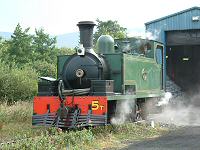''Through mismanagement, the Tralee and Dingle Light Railway Company finances were in a perilous state from the outset, but due to over work and questionable maintenance of the first four engines, they desperately needed another loco. Only one engine was working and a pony and trap had to be bought to carry the mails! No.5 (coincidently Hunslet works no. 555) was ordered in 1891, three years after its early stable mates. Hunslet gave a cash price for No.5 at £1835 but as it had to be paid for in instalments over three years it ended up costing the company £2080. It was delivered in 1892 and in its original form became one of the earliest locos to be fitted with oil firing (Holden's Patent oil firing apparatus). 'Why' isn't known but one story goes that the T&D engineer at the time had either been trained by, or worked under, Holden himself. It could also have been that a 'hard to refuse' deal was struck for Hunslet to experiment with a relatively new system on a narrow gauge locomotive. Despite the oil firing proving a success economically and in terms of performance (units were purchased to convert two other locos which were never used), it was converted to coal firing after only a year. It may be that oil just wasn't that readily available in the extremes of Ireland, or it could have been that in June1893 the Tralee and Dingle had just appointed a new locomotive foreman and his aversion to oil firing caused the conversion.
Whether it was the oil firing apparatus or complaints about the earlier loco 's cab size, I'm not sure, but the cab ended up being an extra 6'' long. When the Tralee and Dingle's Hunslets went on their travels around the Irish Narrow Gauge (West Clare and Cavan and Leitrim) cab size proved to be one of the unpopular features of these locos. No. 5's 'main' claim to fame however was that it was the first British narrow gauge 2-6-2 tank engine loco fitted with inside frames.
Being a popular loco amongst the crews it was worn out by 1902 having travelled about 2000 miles a month for a couple of years and a major overhaul was performed 'patching' up the engine to keep it running. By 1906 a new boiler was needed and a larger one was ordered and fitted raising the boiler pressure to 150lb/in. and the tractive effort from 10700lbs to 11500lbs. It was always nominally more powerful than its sisters. No.5 then had a busy but humdrum existence for a number of years. She was used for a failed experiment in turf burning in 1944 during the massive coal shortages in Ireland at the time, though only managed to reach Emalough before the fire ran out. She was abandoned there for about a week until rescue came in the form of a truck of coal! By 1948 though the loco was worn out and stuck at the back of Tralee shed, making one last run in 1949. She was sent to Inchicore works outside Dublin where repairs were done before travelling to the Cavan and Leitrim in 1950, lasting there to the end. In 1959 No. 5 was sold to Steamtown USA in Pennsylvania but with a lot of hard work and good fortune was finally repatriated in 1986, restored and, amazingly, back in steam by 1992 and now runs on the Tralee and Blennerville Railway, a short section of the original line.
As with other questions relating to the difference in No.5 to the other locos, it seems odd that a 2-6-2 was purchased. Many Hunslet locos have a certain 'gait' and in the same way that Baldwin attached an extra pony truck at the rear of their War Dept. locos so Hunslet may have pre-empted them, in this case to improve running in both directions possibly with the aim of saving having to turn the loco, although it always was! Turntables were provided at Tralee, Castlegregory, Castlegregory Junction and Dingle. Interestingly the 'pit' (in inverted commas as it was rectangular!) at Castlegregory Junction has a date marked in the concrete as September 1907. If the one at Castlegregory itself was put in at around the same time [it was I since found out], then it could be that the loco was bought for the 'branch' [unlikely as the loco shortage was so acute they would not have had the luxury of doing this] to avoid it having to be turned. It would be interesting to know the truth!"

Blennerville 2003

Steamtown, USA